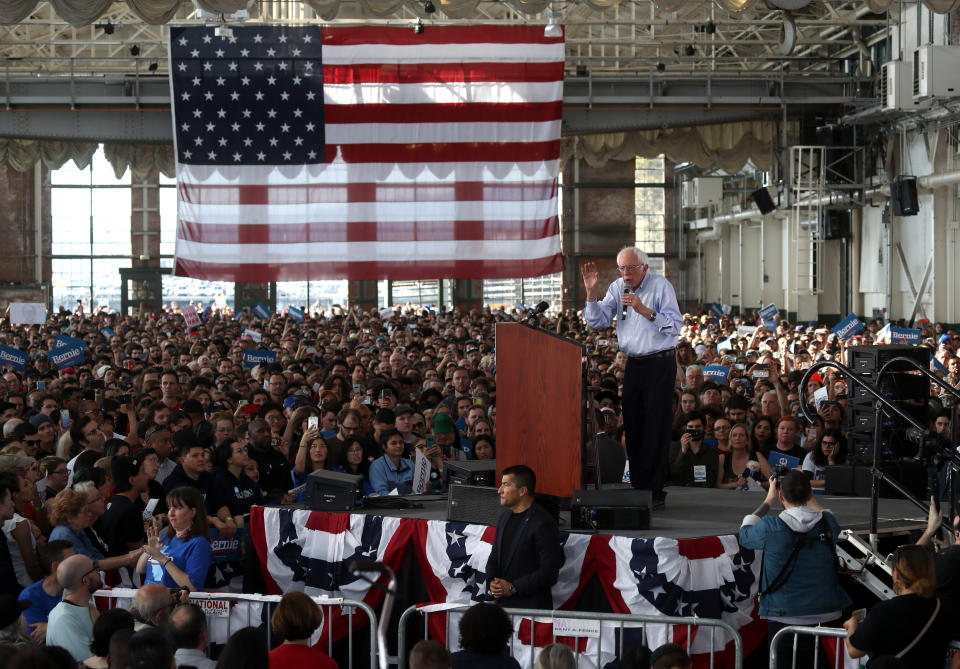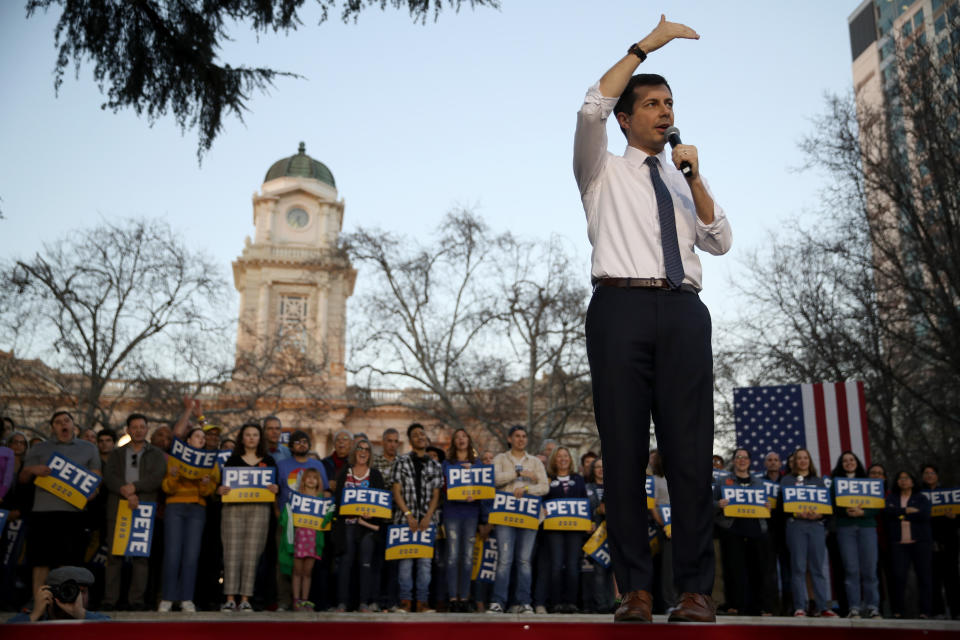Battle For California Heats Up Ahead Of March 3 Democratic Primary
An unusually large field of candidates and the Iowa caucus fiasco has made California, the most populous and diverse state in the nation, more relevant than ever this year in the race for the Democratic presidential nomination.
With 494 delegates up for grabs (more than 10 percent of the total) as part of the big batch of Super Tuesday nominating contests on March 3, the Golden State could shake up the race and boost one or more candidates provided they meet the required 15 percent threshold of support at the congressional district or statewide level.
Most polls have shown Sen. Bernie Sanders (I-Vt.) with a healthy lead, though things could still change after Nevada and South Carolina heads to the polls this month. A clear-cut victory for the senator in California would solidify his path to the nomination and lower the chances of a contested convention this summer.
If a large number of candidates remain viable, however, the state party’s proportional system of allocating delegates could rob Sanders of a decisive net advantage. Former New York City Mayor Michael Bloomberg, Sen. Elizabeth Warren (D-Mass.), former South Bend Mayor Pete Buttigieg, and former Vice President Joe Biden have all made stops there and are clustered near the 15 percent threshold, according to a recent survey from Capitol Weekly.
What makes the battle for California different this year (in addition to the state’s earlier primary date) is that its large number of unaffiliated voters, or No Party Preference (NPP) voters, can request a special ballot or even switch parties to cast a vote for the candidate of their choice. As of October 2019, more than 5.4 million of the state’s 20 million registered voters had selected no party preference ― outnumbering registered Republicans.

Sanders’ campaign, in particular, has made a big effort to reach those voters this cycle. His team opened a hotline where voters can call with questions, and has educated its canvassers and phone bankers on how to speak to voters in four different languages about getting the right ballot. Sanders, who himself is an independent, has spoken about the ballot issue during campaign events in the state, urging rallygoers to request a Democratic ballot “so that we can win here in California.”
“This is the most consequential election in the modern history of our country,” Sanders said at a Monday rally in the San Francisco Bay Area. “I think you all know, you are the largest state in this country. You have the most delegates to the Democratic National Convention. The candidate who wins here in California stands a pretty good chance to win the nomination.”
The Vermont senator is a known commodity among California voters ― he received 46 percent of the vote share in the state’s 2016 Democratic presidential primary, which then took place in the month of June. Sanders is positioned to do well again. He’s made concentrated efforts to reach Latino voters this cycle, as well as those who reside in the rural areas of the state like the Central Valley, which could make even more of a difference for his California campaign operation.
Bloomberg could complicate Sanders’ play for a clean delegate haul in California, however. The self-funding billionaire who made a late entry into the race has flooded the state with ads, a strategy that has made him competitive. His campaign has more than 300 full-time staffers on the ground in more than 20 offices across the state ― an organization made possible by his sheer wealth and decision to skip the first four nominating contests. He’s also picked up endorsements from prominent California Democrats such as San Francisco Mayor London Breed and former Los Angeles Mayor Antonio Villaraigosa.
“The data shows we’re competitive in every district across California,” Will Dubbs, deputy states director for Bloomberg’s campaign, told HuffPost.
Warren’s campaign has three offices in California (Los Angeles, Oakland, and San Francisco) and more than four dozen paid staff. Her campaign has been on the ground in the state since last summer. The Massachusetts senator is looking for a strong performance in the Golden State after disappointing finishes in Iowa and New Hampshire.
Other campaigns have little to no infrastructure set up in California so far, however. Though he finished a close second place in New Hampshire behind Sanders, Buttigieg has only begun staffing up in the state. The 38-year-old former mayor held two events in Northern California last week, and his campaign said there’s more to come.

“We are thrilled with the progress of this campaign, but we’re only two states in. So much depends on what happens next,” Buttigieg told a crowd near Sacramento City Hall on Friday. “And so much depends on what happens when the future-oriented, forward-looking, racially diverse, justice-minded state of California has its say.”
Biden, meanwhile, is focused on resuscitating his struggling campaign in Nevada and South Carolina. The former vice president has the backing of top California Democrats, including Sen. Dianne Feinstein, Los Angeles Mayor Eric Garcetti, and Secretary of State Alex Padilla. But like in most national surveys, Biden’s support among California voters has dropped sharply following his losses in Iowa and New Hampshire.
Most California voters received their absentee ballot earlier this month, a full month before election day. Roughly 1 million Californians have already mailed theirs in as of Tuesday, according to a Capitol Weekly tracker. The data shows Democrats are lagging behind Republicans in returning their ballots ― suggesting many Democratic voters are waiting to see how the race develops before deciding who should lead their party in taking on Trump in November.
“Voters in California — and especially Democrats — are congenitally late voters,” said veteran California Democratic strategist Garry South. “They don’t rush to return their ballots until they get a sense of what’s going on with the candidate field.”
If most California Democrats hold off on making their choice until after the South Carolina primary on Feb. 29, it could take potentially up to two to three weeks to determine the ultimate winner in a state already known for its slow vote counting. That would mean that top-placing candidates could miss out on momentum they’d have otherwise gained on or immediately after election night.
Sanders supporters at his rally in Northern California on Monday seemed optimistic that the earlier primary date will help Californians have a voice in the nominating process.
“I think it could definitely help other voters and other states move in a certain direction,” said Lupe Pulido, a Sanders supporter from Richmond. “I do feel that California has a big wave.”
Also on HuffPost
Love HuffPost? Become a founding member of HuffPost Plus today.
This article originally appeared on HuffPost.

